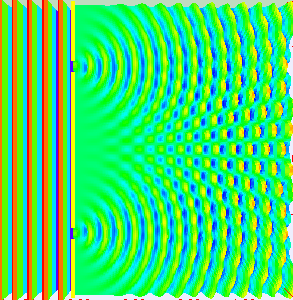I'm not writing anymore physics posts - probably! At least for the foreseeable future. I imagine.
"If quantum mechanics hasn't profoundly shocked you, you haven't understood it yet."
Niels Bohr
I've been busy since 2008 working on an Open University physics degree and I'm currently awaiting the result (gulp...)
I did a project as part of the course (they call it a project, other universities might call it a dissertation) on quantum computing. I can't publish it here as the OU won't let me - and unless you're up to speed with quantum physics it probably wouldn't mean much anyway. However since I've got a little more time on my hands, it's my intention to write a bit about the subject here and aim it at non-physicists 'cos it's an interesting, hot topic.
I'll start by introducing a concept that is often referred to as "quantum weirdness". It's about how things behave when the're small. And I mean really small.
In the seventeenth century, a dude called Isaac Newton (you might have heard of him) theorised on the nature of light. He thought it was composed of streams of tiny particles and this view stood for quite a while and it wasn't until the early 19th century that a bloke named Thomas Young 'proved' that light was actually a wave. He demonstrated the wave-like nature of light by showing interference fringes in his famous 'double slit' experiment:

A similar effect can be seen if you drop two small pebbles into water at the same time - as the waves spread out, they impinge on each other and in places where there are two crests you get a double height crest, two troughs create a double-depth trough and a crest and a trough cancel out when they coincide. it's useful to note that the above image is an apt illustration for water-waves and for light waves but the scales differ by quite a bit. In Young's experiment, there would be a screen set up at the right hand side in the image above and you would be able to see visible fringes of light where the waves reinforce each other and dark areas where the waves cancel. It takes a bit of seeing, but there are sort of channels or rays of uninterrupted green stillness that you can follow out from the right hand side - and these correspond to the dark areas you'd see on the screen. If it were water, these dark bits would be where you'd be getting splashed less.
So light is a wave and all is well and good. Until we get to the beginning of the 20th century.Another chap you might have heard of called Albert Einstein published a paper in 1905 in which he explained something called the photo-electric effect. I won't go into details but this was really the start of quantum physics. People often credit Max Planck as being the guy who brought quantum physics into the world but I think Albert's 1905 bombshell was the more significant event. The essence of it for our purposes is that the photo-electric effect can only be explained if light is treated as individual packets (or 'quanta') of energy and not waves. These quanta of light are known as photons these days. But hang on, Young proved light was a wave and clever guys such as James Clerk-Maxwell and Heinrich Hertz have built a lot of phyics on that wavey foundation. There can be no doubt about it - light behaves like a wave.
And so this is where the weirdness begins - it turns out that light can be a particle or a wave. At the same time. If you look for a wave, you find a wave. If you look for a particle, you find a particle.
Digressing only slightly and coming at this from another direction, you might remember from chemistry lessons at school what an atom is supposed to 'look' like. Actually it doesn't look like anything because it's far too small to look at but at school you were probably taught to think of an atom as a central nucleus with tiny little spherical electrons whizzing around it like little planets. This is pretty much utter bollocks but the point is, electrons are supposed to be tiny particles but it turns out that they can also behave like waves too - depending on how you measure them.
So light and tiny bits of stuff like electrons can be particles and waves at the same time. That's fairly weird but it does get weirder.
Image credit: Lookang many thanks to Fu-Kwun Hwang and author of Easy Java Simulation = Francisco Esquembre - Own work, CC BY-SA 3.0, Link